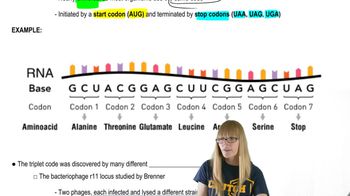What experimental evidence provided the initial insights into the compositions of codons encoding specific amino acids?
Table of contents
- 1. Introduction to Genetics51m
- 2. Mendel's Laws of Inheritance3h 37m
- 3. Extensions to Mendelian Inheritance2h 41m
- 4. Genetic Mapping and Linkage2h 28m
- 5. Genetics of Bacteria and Viruses1h 21m
- 6. Chromosomal Variation1h 48m
- 7. DNA and Chromosome Structure56m
- 8. DNA Replication1h 10m
- 9. Mitosis and Meiosis1h 34m
- 10. Transcription1h 0m
- 11. Translation58m
- 12. Gene Regulation in Prokaryotes1h 19m
- 13. Gene Regulation in Eukaryotes44m
- 14. Genetic Control of Development44m
- 15. Genomes and Genomics1h 50m
- 16. Transposable Elements47m
- 17. Mutation, Repair, and Recombination1h 6m
- 18. Molecular Genetic Tools19m
- 19. Cancer Genetics29m
- 20. Quantitative Genetics1h 26m
- 21. Population Genetics50m
- 22. Evolutionary Genetics29m
11. Translation
The Genetic Code
Problem 2b
Textbook Question
In the experiments that deciphered the genetic code, many different synthetic mRNA sequences were tested.
What was the result of studies of synthetic mRNAs composed exclusively of cytosine?
 Verified step by step guidance
Verified step by step guidance1
Understand the context: The genetic code was deciphered by studying how synthetic mRNA sequences direct the synthesis of polypeptides in a cell-free system. Synthetic mRNAs composed of only one type of nucleotide (e.g., cytosine) were used to determine which amino acids were encoded by specific codons.
Recall the codon structure: Codons are sequences of three nucleotides in mRNA that specify an amino acid. For a synthetic mRNA composed exclusively of cytosine (C), the codons would be CCC, CCC, and so on.
Determine the amino acid encoded by the codon CCC: Using the genetic code table, identify the amino acid that corresponds to the codon CCC. This codon is known to encode the amino acid proline (Pro).
Predict the resulting polypeptide: Since the synthetic mRNA is composed entirely of cytosine, the ribosome would repeatedly translate the codon CCC, resulting in a polypeptide chain made entirely of proline residues.
Summarize the findings: The studies of synthetic mRNAs composed exclusively of cytosine demonstrated that the codon CCC specifies the amino acid proline, and the resulting polypeptide would be a homopolymer of proline.
 Verified video answer for a similar problem:
Verified video answer for a similar problem:This video solution was recommended by our tutors as helpful for the problem above
Video duration:
1mPlay a video:
Was this helpful?
Key Concepts
Here are the essential concepts you must grasp in order to answer the question correctly.
Genetic Code
The genetic code is a set of rules that defines how the sequence of nucleotides in mRNA is translated into amino acids, the building blocks of proteins. It consists of codons, which are triplets of nucleotides, each corresponding to a specific amino acid or a stop signal during protein synthesis.
Recommended video:
Guided course

The Genetic Code
Synthetic mRNA
Synthetic mRNA refers to artificially created strands of messenger RNA that can be designed to contain specific sequences of nucleotides. These synthetic mRNAs are used in experiments to study gene expression, protein synthesis, and the effects of different nucleotide compositions on translation.
Recommended video:
Guided course

mRNA Processing
Polycytidylic Acid (Poly-C)
Polycytidylic acid, or Poly-C, is a synthetic mRNA composed entirely of cytosine nucleotides. Studies involving Poly-C have shown that it predominantly codes for the amino acid proline during translation, illustrating how the composition of mRNA influences the resulting protein synthesis.
Recommended video:
Guided course

mRNA Processing
Related Videos
Related Practice
Textbook Question
541
views


